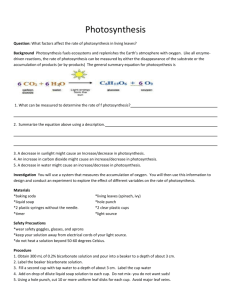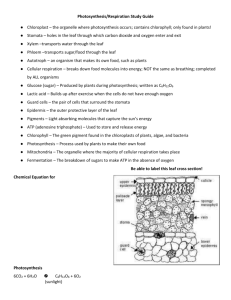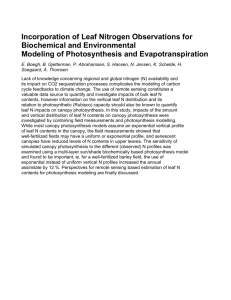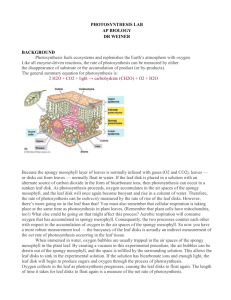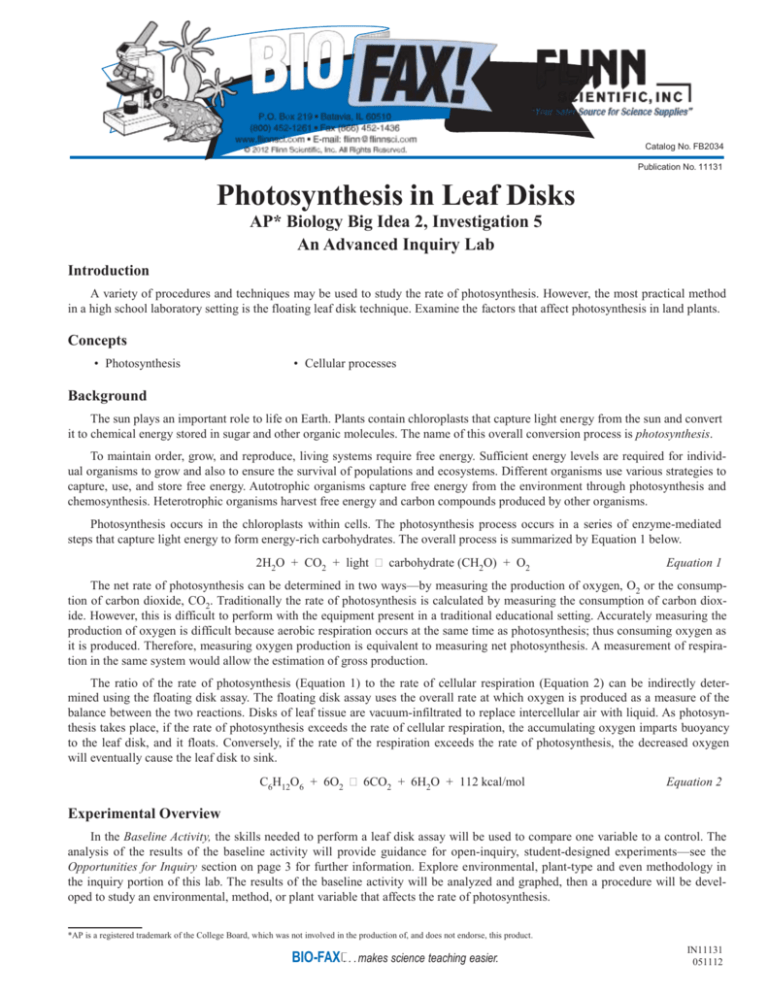
Catalog No. FB2034
Publication No. 11131
Photosynthesis in Leaf Disks
AP* Biology Big Idea 2, Investigation 5
An Advanced Inquiry Lab
Introduction
A variety of procedures and techniques may be used to study the rate of photosynthesis. However, the most practical method
in a high school laboratory setting is the floating leaf disk technique. Examine the factors that affect photosynthesis in land plants.
Concepts
• Photosynthesis
• Cellular processes
Background
The sun plays an important role to life on Earth. Plants contain chloroplasts that capture light energy from the sun and convert
it to chemical energy stored in sugar and other organic molecules. The name of this overall conversion process is photosynthesis.
To maintain order, grow, and reproduce, living systems require free energy. Sufficient energy levels are required for individual organisms to grow and also to ensure the survival of populations and ecosystems. Different organisms use various strategies to
capture, use, and store free energy. Autotrophic organisms capture free energy from the environment through photosynthesis and
chemosynthesis. Heterotrophic organisms harvest free energy and carbon compounds produced by other organisms.
Photosynthesis occurs in the chloroplasts within cells. The photosynthesis process occurs in a series of enzyme-mediated
steps that capture light energy to form energy-rich carbohydrates. The overall process is summarized by Equation 1 below.
2H2O + CO2 + light carbohydrate (CH2O) + O2
Equation 1
The net rate of photosynthesis can be determined in two ways—by measuring the production of oxygen, O2 or the consumption of carbon dioxide, CO2. Traditionally the rate of photosynthesis is calculated by measuring the consumption of carbon dioxide. However, this is difficult to perform with the equipment present in a traditional educational setting. Accurately measuring the
production of oxygen is difficult because aerobic respiration occurs at the same time as photosynthesis; thus consuming oxygen as
it is produced. Therefore, measuring oxygen production is equivalent to measuring net photosynthesis. A measurement of respiration in the same system would allow the estimation of gross production.
The ratio of the rate of photosynthesis (Equation 1) to the rate of cellular respiration (Equation 2) can be indirectly determined using the floating disk assay. The floating disk assay uses the overall rate at which oxygen is produced as a measure of the
balance between the two reactions. Disks of leaf tissue are vacuum-infiltrated to replace intercellular air with liquid. As photosynthesis takes place, if the rate of photosynthesis exceeds the rate of cellular respiration, the accumulating oxygen imparts buoyancy
to the leaf disk, and it floats. Conversely, if the rate of the respiration exceeds the rate of photosynthesis, the decreased oxygen
will eventually cause the leaf disk to sink.
C6H12O6 + 6O2 6CO2 + 6H2O + 112 kcal/mol
Equation 2
Experimental Overview
In the Baseline Activity, the skills needed to perform a leaf disk assay will be used to compare one variable to a control. The
analysis of the results of the baseline activity will provide guidance for open-inquiry, student-designed experiments—see the
Opportunities for Inquiry section on page 3 for further information. Explore environmental, plant-type and even methodology in
the inquiry portion of this lab. The results of the baseline activity will be analyzed and graphed, then a procedure will be developed to study an environmental, method, or plant variable that affects the rate of photosynthesis.
*AP is a registered trademark of the College Board, which was not involved in the production of, and does not endorse, this product.
BIO-FAX . . . makes science teaching easier.
IN11131
051112
Pre-Lab Questions
1. Draw and label a figure showing a cross-section of a typical dicot leaf.
2. Why, in the Baseline Activity, are the floating leaf disks placed in a solution that contains sodium bicarbonate?
3. Why is this method performed using leaves and not roots?
4. Why is the rate at which the disks float an indirect measurement of the net rate of photosynthesis?
Materials
Baseline Activity
Soap solution
Paper towels
Sodium bicarbonate, NaHCO3
Permanent marker
Ivy leaves
Ruler
Water, distilled or deionized
Syringe, 12-mL
Balance, 0.01-g precision
Syringe tip cap
Cups, 10-oz, 2
Support stand
Hole-punch, single
Timer
Light source
Safety Precautions
Hydrochloric acid is toxic by ingestion or inhalation and is severely corrosive to skin and eyes. Sodium bicarbonate is
slightly toxic by ingestion. Wear chemical splash goggles whenever chemicals, heat or glassware is used. Keep water or other
solutions away from electrical cords and outlets. Follow all normal laboratory safety guidelines.
Baseline Activity
1. Using a permanent marker, label one syringe “w/ CO2” and the other “control.” Repeat labels on the plastic cups as well.
2. Prepare 200 mL of 0.2% sodium bicarbonate solution by dissolving 0.4 g of sodium bicarbonate in 200 mL of distilled or
deionized water.
3. Add one drop of liquid dish soap to the solution. Note: Take care to add the smallest possible drop. Too much soap will
cause unnecessary suds in the solution.
4. Prepare 200 mL of the control solution (no carbon dioxide) by adding one drop of soap to 200 mL of distilled or deionized
water.
5. Pour enough bicarbonate solution into the cup labeled “w/ CO2” so that it is approximately 3 cm full.
6. Fill the cup labeled “control” 3 cm with the solution made in step 4.
7. Using a single-hole punch, cut out 20 leaf disks. Avoid cutting leaf disks over major veins in the leaf.
8. Remove the plunger from the syringe.
9. Place 10 leaf disks into the barrel of each syringe.
10. Carefully replace the plunger to avoid crushing the leaf disks. Push the plunger until only a small volume of air and leaf
disks remains in the barrel, less than 10% of the volume. Note: Steps 10–18 will also need to be performed with the control solution. This may be done simultaneously by another group member or one after the other.
11. Using the syringe labeled “w/ CO2,” pull a small volume of the sodium bicarbonate solution into the syringe, about 3 mL.
Tap and swirl the syringe to suspend the leaf disks in the solution.
12. Place the syringe tip cap on the syringe.
–2–
IN11131
© 2012 Flinn Scientific, Inc. All Rights Reserved. Reproduction permission is granted only to science teachers who have purchased Photosynthesis in Leaf Disks, Catalog No. FB2034, from Flinn
Scientific, Inc. No part of this material may be reproduced or transmitted in any form or by any means, electronic or mechanical, including, but not limited to photocopy, recording, or any information
storage and retrieval system, without permission in writing from Flinn Scientific, Inc.
13. Make sure the disks are suspended in solution by lightly shaking the syringe and then draw back the plunger to create a
vacuum. Hold the vacuum for approximately 10 seconds. While holding, swirl the leaf disks to keep them suspended in
solution.
14. Release the vacuum. The bicarbonate solution will infiltrate the air pockets in the leaf causing the leaf disks to sink.
Repeat step 13 up to three times until all the disks sink. If the disks do not sink after three trials add a second very small
drop of soap to the bicarbonate solution and repeat steps 10–14.
15. Add fresh sodium bicarbonate solution (step 3) into a clean 200-mL beaker to a depth of approximately 3 cm.
16. Transfer the leaf disks and the solution in the syringe to the beaker.
17. Place the leaf-disk solution under a light source. The top of the beaker should be approximately 8from the light.
18. Start the timer. At the end of each minute, record the number of floating disks. Then swirl the disks to release any disks
that are stuck against the side of the cups. Continue for 10 minutes or until all disks float.
Analysis
Calculate the ET50, the time required for 50% of the leaf disks to float by making a graph measuring Number of Disks vs.
Time (min) with the disks from the “w/ CO2” cup.
Opportunities for Inquiry
1. Consider the following questions while reflecting upon your knowledge of photosynthesis.
a. How might biotic and abiotic factors in the environment, such as light, pH, temperature, etc. affect the rate of
photosynthesis?
b. Do all leaf types photosynthesize at the same rate? Does the type, color or age of the leaf affect the rate of photosynthesis? Do all plant tissues have the same rate of photosynthesis?
c. How do method variables such as depth of solution, data collection method, etc vary the rate of photosynthesis?
2. Plan, discuss, evaluate, execute and justify an experiment to determine how an environmental variable, plant/leaf variable,
or method variable affects the rate of photosynthesis.
a. Develop a testable hypothesis.
b. Discuss and design a controlled experiment to test the hypothesis.
c. List any safety concerns or precautions that will be taken to protect yourself, your classmates and your instructor during
the experiment. Do monocots, dicots, C3, C4 or water plants all have the same ratio of photosynthesis?
d. Determine how you will collect and record raw data.
e. How will you analyze raw data to test your hypothesis?
f. Review your hypothesis, safety precautions, procedure, data tables, and proposed analysis with your instructor prior to
beginning your experiment.
g. Once the experiment and analysis are complete, evaluate your hypothesis and justify why or why not the hypothesis
was supported by your data.
h. Present and defend your findings to the class.
i. Make suggestions for a new or revised experiment to modify or retest your hypothesis.
–3–
IN11131
© 2012 Flinn Scientific, Inc. All Rights Reserved. Reproduction permission is granted only to science teachers who have purchased Photosynthesis in Leaf Disks, Catalog No. FB2034, from Flinn
Scientific, Inc. No part of this material may be reproduced or transmitted in any form or by any means, electronic or mechanical, including, but not limited to photocopy, recording, or any information
storage and retrieval system, without permission in writing from Flinn Scientific, Inc.
Teacher’s Notes
AP Biology—Photosynthesis in Leaf Disks
Materials Included in Kit (for 8 groups of students)
Hydrochloric acid, HCl, 1 M, 100 mL
Hole-punch, single, 4
Soap solution, 30 mL
Syringe, 12-mL, 16
Sodium bicarbonate, NaHCO3, 20 g
Syringe tip cap, 16
Cups, 10-oz, 16
Additional Materials Needed
Water, distilled or deionized
Light sources, 8
Ivy or spinach leaves†
Support stands, 8
Balance, 0.01-g precision
Timers, 8
†Other leaf types may be required as well, depending on student experimental design.
Lab Hints
• Use a bulb that is at least 40 W. The sample data provided was obtained using a 40 W bulb that was 18 cm from the top of
the lab bench.
• Ivy leaves should ideally be obtained from a plant so they are as fresh as possible.
• Use the freshest possible spinach leaves for optimal results. Pre-cut spinach in the bags will work but it takes 5–10 minutes
longer on average for the disks to float.
• Do not use wilted spinach. The best pieces are found on the stiff leaves and are not cut through veins.
• If students perform the experiment as done in the Baseline Activity until the disks float and then place the cup with the
floating disks in a dark location the disks will re-sink. This is due to plant respiration consuming oxygen bubbles.
• Rinse plastic cups from the Baseline Activity for use in the Opportunities for Inquiry portion.
Teaching Tips
• Students often have the misconception that plants only undergo photosynthesis and animals undergo cellular respiration.
Plants also have mitochondria and respire.
• Have students view prepared microscope slides of leaf cross-sections to review leaf anatomy prior to beginning this lab.
• Complete a stomata peel to study leaves as part of the Baseline Activity. Contact Flinn Scientific and request BioFax
10226, Lasting Impressions—Counting Stomata.
• Extend the activity using Mitochondrea in Action, Flinn Catalog No. FB1823.
Answers to Pre-Lab Questions
1. What is the purpose of creating a vacuum with the floating leaf disks?
When immersed in the experimental solution oxygen bubbles are trapped in the air pockets of the mesophyll layer of the
plant leaf. By creating a vacuum the air is drawn out of the leaf and replaced with the bicarbonate solution, allowing the
disk to sink.
2. Why, in this experiment, are the floating leaf disks placed in a solution that contains sodium bicarbonate?
The bicarbonate ions serve as the carbon source for photosynthesis.
3. What causes the disks in the bicarbonate solution to rise after they are placed under a light source?
During the photosynthesis process oxygen is produced changing the buoyancy of the disk causing it to rise.
4. Why is the rate at which the disks float an indirect measurement of the net rate of photosynthesis?
Cellular respiration is occurring simultaneously which consumes the oxygen as it is produced by photosynthesis.
Teacher’s Notes continued
© 2012 Flinn Scientific, Inc. All Rights Reserved.
IN11131



